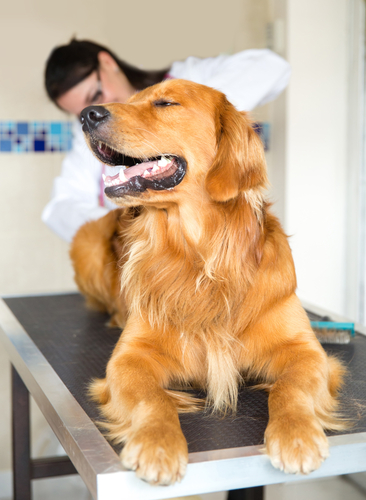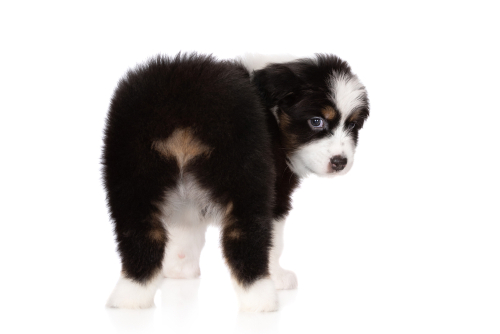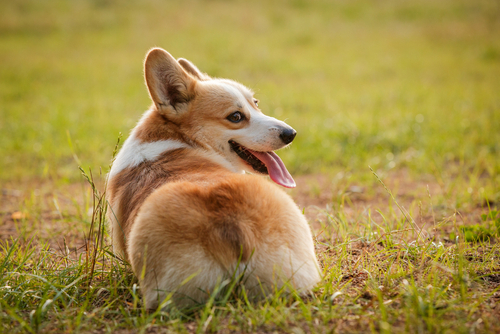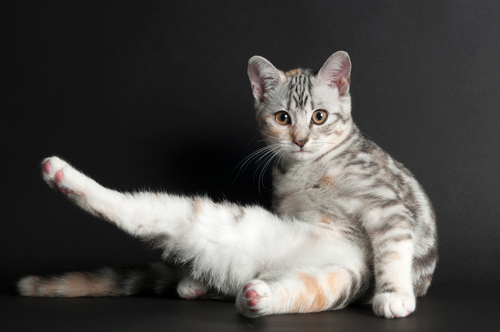Pet Insurance Review > Pet Wellness Guides > A Pain in the Behind: Anal Gland Problems in Pets - Pet Insurance Review
A Pain in the Behind: Anal Gland Problems in Pets
Posted: 06/27/2022 | BY: Erin Cain | Categories: Cat , Dog , Health problems , Pet care
Anal gland problems are surprisingly common in dogs and cats. If your pet has trouble with their anal glands, they may scoot or drag their behind on the ground. They may also lick their anal area excessively, have discharge from that area, and experience significant pain. This blog post will discuss common anal gland complications, how to identify them, and most importantly, how to resolve them.

What are anal glands?
Two small glands located just inside the anus are called anal glands or anal sacs. These pouches are situated between the external and internal sphincter muscles. Wild animals can empty or express their anal glands to mark territory via scent or as a defense mechanism. The secreted substance is an oily brown fluid that packs a strong odor similar to skunk spray.
Dogs and cats usually expel this liquid inside these pinhole-sized sacs when defecating. Firm, healthy stools will naturally push the fluid out of the anal glands. However, suppose a pet has poor bowel movements (diarrhea or loose stools). In that case, the sac material thickens, making it challenging for the animal to pass the liquid. The cat or dog’s stool is not firm enough to expel the glands. The initial result is a dog or cat licking around his genitals or a dog scooting on his bottom across the floor.
If the pet’s anal glands aren’t emptied, they can become impacted, and an abscess forms. That abscess may break through the skin, releasing anal gland fluid and producing a painful, bloody, and stinky mess. Anal gland impaction may happen to a pet once, or it can be a continual medical issue.

What causes anal glands to become infected?
There are various reasons a dog or cat’s anal glands may become inflamed and infected. Some of those reasons include:
Diet
Your pet’s diet plays a substantial role in whether they develop anal gland problems. A balanced and appropriate diet with the right amount of fiber allows for proper stool formation that easily expels anal gland fluid. However, if a cat or dog’s diet consists of processed foods or improperly prepared or cooked foods, the resulting loose stools are not strong enough to push on the anal glands to expel the liquid.
Obesity
Overweight and obese pets seem to have more trouble with their anal glands than those in a normal weight range. The extra body fat in the pet’s anal region makes it harder for the pet to expel the glands naturally. This problem occurs as there is less pressure when feces passes and pushes on those areas.

Breed influences
Anal gland problems are rare amongst large breed dogs and all cats. However, small breed dogs, such as Poodles, Beagles, Cocker Spaniels, Lhasa Apsos, and Chihuahuas, seem to represent a higher proportion of pets with anal gland problems.
This disparity may be due to small breed dogs having a higher likelihood of being anxious and nervous. That condition may cause them to shiver and shake, affecting their stool’s firmness. Additionally, small dogs tend to be less active than larger breed dogs. Their rump muscles are not as strong or defined, making it difficult to express the anal glands.
Age factors
Older pets are more likely to suffer from impacted anal glands than younger ones. This situation may be due to senior dogs and cats having more difficulty squatting long enough and pushing with enough pressure when defecating. Add in common senior medical issues, like arthritis and old injuries, and it’s doubly challenging for an older pet to expel the sacs when going to the bathroom.
Grooming issues
There is controversy about whether all healthy pets should have their anal glands expressed regularly. Some veterinarians argue that a typical cat and dog without anal gland problems should never have their sacs expressed unless medically necessary.
However, professional groomers often express a pet’s anal glands as a regular part of a grooming session. If you are afraid your pet may have its anal glands expressed too often during grooming, ask the groomer to skip that part of the session.

What are the differences in anal gland infections in dogs and cats?
Although cats and dogs can experience infected anal glands, it’s more common in canines than felines. This situation is good news for veterinarians everywhere, as trying to express a cat’s anal glands is a highly challenging prospect. Whether your dog or cat suffers from this health condition, veterinarians recommend that you bring your pet to the animal hospital. Avoid expressing your cat’s or your dog’s anal sacs at home.
What are the common symptoms of anal gland problems?
Both dogs and cats share some symptoms of impacted anal glands, although there are slight differences. In some ways, impaction of the anal glands in dogs is dissimilar from those in cats:
Signs in cats
- licking and biting their behind
- foul odor
- litter box avoidance
- crying and hiding
- scooting or dragging their butt on the floor
Signs in dogs
- excessive licking and biting near the rectum
- difficulty or reluctance to sit
- bloody feces
- foul odor
- dragging or scooting their itchy butt on the ground
- chewing at the hip or the base of the tail
- pus or blood on the dog’s bedding, the carpet, or where they commonly rest
- vocalizing or straining due to severe pain while defecating
- bulging or swelling of the skin under the rectum
- the anal area appears red and irritated
Problems with anal sacs are uncomfortable and extremely painful for pets. If you suspect your pet has anal gland issues, get him to the veterinarian immediately.

Treatments for anal gland impaction in dogs and cats
Initial treatment for most pet patients involves a veterinarian or veterinary nurse manually expressing the anal sacs. The frequency of anal gland expression depends on how much discomfort the pet may be experiencing. Treatment can range from every week to every month for dogs and cats who repeatedly suffer from anal sac impaction or other recurring anal gland issues.
Veterinarians recommend letting professionals address a pet’s anal gland infection or impaction. Two manual expression steps are required: an external and internal expression of anal gland material. For the external expression, the vet gently squeezes and empties the sacs using a cloth or tissue. The internal expression involves the vet inserting a gloved index finger and thumb into the rectum, then gently squeezing and emptying one sac at a time. This method tends to be the more successful of the two.
These approaches must be made with care, especially because of how painful the process can be for your dog or cat. Improperly expressing the anal glands can further damage your pet’s medical issues and cause more pain. Therefore, it’s best not to express your dog’s anal glands or cat’s anal sacs by yourself.
The affected sac may need to be flushed out with water if it is severe or infected. Since these conditions are excruciating, some pets require sedative and anesthetic drugs, so they do not feel any pain during this treatment process. A combination of oral antibiotics and a corticosteroid medication injected into the affected anal sacs are other methods of addressing an anal gland problem.
Surgery is the only option in severe scenarios when the glands are abscessed. An anal sacculectomy, or complete removal of the glands, is typically the best procedure to handle recurring anal gland issues, abscesses, and infections.

Prevent anal gland problems in your pet
There are simple steps you can take to prevent anal gland problems in your pet, or at least limit them for those breeds predisposed to them:
- You can help your pet avoid any potential anal gland problems by ensuring they’re getting enough fiber in their diet. Talk to the vet about putting them on a healthy food plan that will work for digestion and stool production.
- Keep your pet at a healthy weight. Your vet will know what nutritional requirements vary depending on breed, so ask them what you need to do to help your pet avoid anal gland problems.
- Ask your professional groomer to avoid anal expression when your pet gets a trim. Let your veterinarian or veterinary nurse handle anal gland expression in a medical clinic.
These steps can go a long way toward preventing your pet from experiencing painful infected or abscessed anal glands.
Pet insurance can ease the pain of emergency care.
While it’s never a pleasant thing to think about, anal gland problems are common enough that pet parents should know what to watch for in their dog or cat. Depending on the severity of the situation, you may face high veterinary bills for an unexpected exam and medications for your pet’s health issue. With a pet insurance plan, up to 90% of those costs are reimbursed by your pet insurance policy. Get a free quote today, and let Pet Insurance Review find the best providers’ deals for you and your pet.
References:
- Kaye, J. (2022). What You Should Know About Your Pet’s Anal Sacs. Retrieved from https://www.mspca.org/angell_services/what-you-should-know-about-your-pets-anal-sacs/
- Abraham, M. (2022). Anal gland impaction. Retrieved from https://www.thekennelclub.org.uk/health-and-dog-care/health/health-and-care/a-z-of-health-and-care-issues/anal-gland-impaction/
- De Jong, D. (2019). Tweaking dog’s diet should help glands. Retrieved from https://www.bostonherald.com/2019/12/29/tweaking-dogs-diet-should-help-glands/
- Brooks, W. (2019). Obesity is Unhealthy in Dogs and Cats. Retrieved from https://veterinarypartner.vin.com/default.aspx?pid=19239&id=4952934
- Khuly, P. (2021). Expressing Anal Glands: The Good, the Bad, and the Disgusting. Retrieved from https://www.embracepetinsurance.com/waterbowl/article/expressing-anal-glands
- Valentini, K. (n.d.). What to Know About Anal Gland Problems in Cats. Retrieved from https://www.dailypaws.com/cats-kittens/cat-grooming/cat-anal-glands
- Heintz, A. (2017). Anal Glands Can be a Real Pain in the Butt! 5 Things You Need to Know. Retrieved from https://countrycareac.com/2017/01/09/anal-glands/
- Kuan, S. (2021). Anal Sac Problems & Anal Sacculectomy. Retrieved from https://sashvets.com/diseases/anal-sac-problems/
The information contained on this blog is intended for informational and educational purposes only and should not be construed as medical advice. It is not a substitute for professional veterinary care. Always consult with your veterinarian before making any changes to your pet's health care or treatment plan.
The authors of this blog are not veterinarians and do not claim to be experts in pet health. The information provided here is based on our own experiences and research, as well as information from reputable sources. However, we cannot guarantee the accuracy or completeness of this information.
We encourage you to do your own research and consult with your veterinarian before making any decisions about your pet's health.